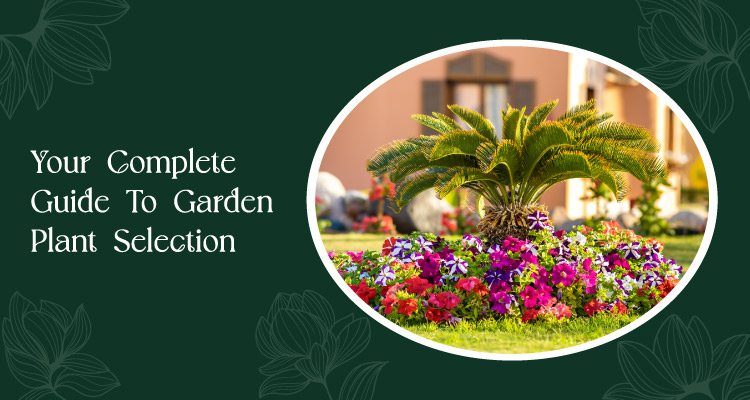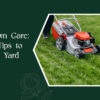Creating a garden is one of the exciting journeys that demands combining creativity, functionality, and sustainability. However, making the right choices when selecting plants and flowers for your garden requires careful consideration. We provide expert garden services in India.
In this guide, we will explore your outdoor space to plant selection that fits your climate and purpose, such as aesthetic or functional. Whether you have small gardens or large sprawling landscapes, the right selection can enhance your outdoor space.
1. Understanding Your Garden
Before making your garden plant selection, take some time to understand the basics of your garden, such as:
- Assess Your Space: The more space you have in the garden, the more it can accommodate. A compact plant or a vertical garden could be used in smaller areas, whereas larger areas allow for mass planting and tall flowers like trees and bushes.
- Sunlight Exposure: Consider the hours of sunlight your garden receives in the daytime. Some areas will have full sunlight, and others will be shaded throughout the day. It is essential for plants that can survive in both conditions without damage.
- Soil Type: Understand your soil type and see if it’s quite sandy, clayey, or loamy. Checking your soil type will provide you with an understanding of its pH and nutrient content, and this will help you select plants that grow well under the current conditions.
- Climate Considerations: Ensure your plants survive in any weather condition by using equipment like USDA hardiness zone maps for your area, and choose plants, which will be right for the local conditions.
Find the Best Plants for Your Garden
Start Your Journey Here!
2. Types of Plants to Consider
Choosing the right plants for your garden can transform your boring space into a beautiful space. Here are some options available to explore:
Flowering Plants
Flowers are the heart of any garden, it adds colour and vibrancy:
- Seasonal Flowers: Opting options like marigolds, zinnias, and pansies bloom for specific periods, ensuring seasonal beauty in your garden.
- Perennials: Roses, lavender, and hydrangeas give year-round beauty.
- Tips: Coordinate colourings and blooming times to keep up the aesthetic. Landscape plants that attract pollinators, such as bees and butterflies.
Foliage Plants
Foliage flowers add texture and dimension to your garden design:
- Varieties like ferns, caladiums, and hostas upload lush greenery.
- It is known for ornamental leaves for visual attraction.
- It can create a layered appearance or as borders for pathways.
Edible Plants
A functional garden consists of plants that will provide sparkling produce:
- Herbs: Basil, thyme, and parsley are easy to grow and have multiple uses in cooking.
- Vegetables: Choices such as tomatoes, lettuce, and spinach are healthy and fulfilling.
- Fruits: Berry bushes or citrus trees provide sparkling harvests and a visual hobby.
Trees and Shrubs
Trees and shrubs are important to give structure and functionality to the garden:
- Shade Trees: Maple, oak, or neem trees create natural cooling zones.
- Ornamental Shrubs: Bougainvillea, hydrangea, or azaleas add a screen of beauty around you.
3. Plant Selection Based on Purpose
Aesthetic Appeal
If your priority is a visually stunning garden, consider the following factors for landscaping for gardens:
- Colour Themes: Use complementary or contrasting colours to create harmony.
- Focal Points: Utilize colourful flowers such as dahlias or sunflowers as they attract attention.
- Layering: Position the taller flowers on the back side and the shorter ones on the front to add depth.
Functional Needs
Apart from aesthetics, gardens can serve practical purposes as well:
- Shade: Trees like jacaranda or banyan provide natural colour.
- Privacy: Dense shrubs, which include boxwood or bamboo act as natural obstacles.
- Windbreaks: Hardy plants like conifers guard your lawn from strong winds.
Wildlife-Friendly Gardens
Create a sanctuary for local wildlife by choosing flora and fauna-friendly plants.
- Pollinators: Bees and butterflies are attracted to lavender, daisies, and marigolds.
- Birds: Plants with berries, like holly or viburnum, are helpful for birds as it is a food source.
- Habitat Plants: Native grasses or shrubs may provide shaded cover for small animals.
4. Plant Maintenance Needs
High-Maintenance vs. Low-Maintenance Plants
Determine how much time and energy can be devoted to your garden
- High-maintenance plants: Roses, orchids, and bonsai trees that require regular care, pruning, and fertilizing.
- Low-Maintenance Plants: Succulents, cacti, and native plants are low on the attention/maintenance scale.
General Care Tips
- Water deeply but less often to encourage strong root systems.
- Mulch around flowers to keep moisture and prevent weeds.
- Use organic fertilizers to enhance soil fertility.
Seasonal Care
Adjust your renovation routine based totally on the season. For example, prune perennials in early winter, mulch at some stage in summer, and protect sensitive plants from frost in winter.
5. Sustainability in Garden Plant Selection
Sustainable gardening practices are best for both the environment and your garden’s health:
- Native Plants: These plants easily adapt to your local conditions and require much less water and care.
- Drought-Tolerant Plants: Succulents, lavender, and sage are excellent for areas with limited rainfall.
- Avoid Invasive Species: Avoid damaging the ecosystem by not using invasive species such as kudzu or water hyacinth.
- Eco-friendly practices: Adapt composting organic waste, harvesting rainwater, and companion planting to minimize chemical use.
6. Common Mistakes to Avoid
Overcrowding Plants
Planting too close together can lead to light, water, and vitamins competition. Ensure that appropriate space is provided for plants according to their mature size to allow them to grow perfectly.
Ignoring Growth Patterns
Research every plant’s growth habits. For example, some plants grow more aggressively or taller than expected and overshadow the smaller ones, affecting their growth.
Neglecting Seasonal Changes
Consider planting and dormant seasons to keep your garden vibrant throughout the year. Blend evergreen plants with seasonal bloomers for non-stop appeal.
Connect With Us Today
For expert advice and personalized solutions for your green space needs.
Call: +91-84339 29564 | Email: info@lucentcorporation.com
Conclusion
A well-designed garden is more than just a collection of plants in your spare area; it’s a space that reflects your preference and personality and connects you with nature. By working with a reliable landscaping company in India, you could bring your vision to life with expert recommendations and thoughtful execution. Whether selecting the proper plant or ensuring long-time maintenance, the right partner can make your garden a space you’ll cherish for years to come.

Mr. Dilip Murkute
As the founder of Lucent Gardens, Mr. Dilip Murkute draws from his years of experience in hospitality and entrepreneurship. His vision is to create functional, aesthetically pleasing green spaces. Under his leadership, Lucent Gardens delivers sustainable, high-quality landscaping solutions with a commitment to excellence and innovation.




